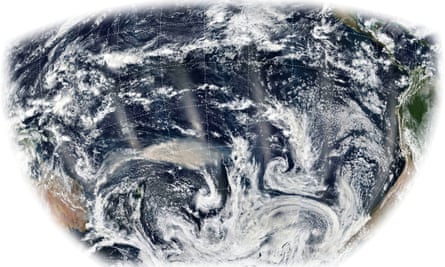Smoke from the 2019-20 bushfires in Australia caused a bloom of phytoplankton in the Southern Ocean larger than the entire Australian continent, according to new research.
An international team of scientists discovered via satellite data that the bloom of phytoplankton – microscopic marine algae – occurred in the ocean between South America and New Zealand beginning in October 2019 and lasting about four months.
Smoke clouds from the Australian Black Summer bushfires travelled into the stratosphere and circumnavigated the globe, depositing aerosol particles thousands of kilometres away from Australia.
The study, published in the journal Nature, found the blooms were the result of iron particles in the smoke aerosols.
The study’s co-author Prof Peter Strutton, of the University of Tasmania’s Institute for Marine and Antarctic Studies, likened the phytoplankton bloom to “the entire Sahara desert turning into a moderately productive grassland for a couple of months”.
Phytoplankton requires iron for photosynthesis. “The entire Southern Ocean is basically low in iron because it’s a long way from dust sources, so any small amount of iron that gets deposited there can cause a strong response,” Strutton said.
Phytoplankton blooms are visible from space and occur when there is abundant sunlight and nutrients, leading to an explosion in population. The massive Southern Ocean bloom occurred at a time of year when phytoplankton activity is usually at a minimum.

The researchers estimate the amount of carbon taken up by phytoplankton cells as a result of the bloom was equivalent to around 95% of the emissions generated by the 2019-20 bushfires.
For that carbon to be permanently removed from the atmosphere, however, the phytoplankton cells would have to sink into the deep ocean and be stored there, Strutton said.
“There’s a lot of recycling of energy and biomass that happens in the surface waters. It’s likely that a lot of that carbon that was initially taken up might have been re-released to the atmosphere when those phytoplankton cells started to break down or were eaten.”
The team did not look specifically at the wider marine ecosystem effects of the large Southern Ocean bloom, but the moderate increase in phytoplankton activity over several months could also have had an impact on fish populations, Strutton said.
Prof Martina Doblin, the director of the Sydney Institute of Marine Science at the University of Technology Sydney, who was not involved in the research, said analysis her team conducted during the fires confirmed there were higher concentrations of iron and other nutrients in the bushfire smoke compared to normal air pollution.
“The nutrient content will have come from the plant and soil material that has been burnt. Those nutrients, normally in a terrestrial system, have ended up in the ocean,” she said.
Quick GuideHow to get the latest news from Guardian Australia
Show

Email: sign up for our daily morning and afternoon email newsletters
App: download our free app and never miss the biggest stories
Social: follow us on YouTube, TikTok, Instagram, Facebook or Twitter
Podcast: listen to our daily episodes on Apple Podcasts, Spotify or search "Full Story" in your favourite app
Preliminary data from Doblin’s own research in estuaries is “aligned with this notion that the aerosols can have impacts on phytoplankton growth”.
The findings come as a separate study, also published in Nature, estimated more precisely the amount of carbon dioxide emitted by the 2019-20 bushfire season.
Using satellite data, an international group of researchers found the fires emitted 715m tonnes of carbon dioxide between November 2019 and January 2020, exceeding Australia’s usual annual fire and fossil fuel emissions by 80%. One previous estimate had put the figure at about 830m tonnes.
